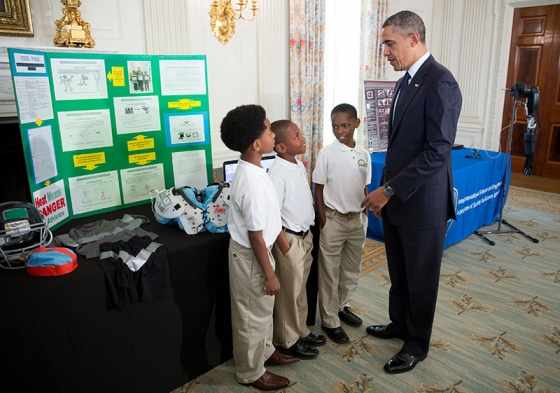Barack Obama has been a president of many firsts. He’s the first African-American president, he’s the first president to publically support same-sex marriage, and he is the first to host a science fair in the White House. While the first two are very important milestones, the latter may be equally impactful.
A self-proclaimed “big science guy,” Obama started the White House Science Fair in 2010 with a simple message: “If you win the NCAA championship, you come to the White House. Well, if you’re a young person and you’ve produced the best experiment or design, the best hardware or software, you ought to be recognized for that achievement, too.” Through the science fair, Obama wanted to “show young people how cool science can be.” In that, President Obama has certainly succeeded.
The White House Science Fair has grown every year. This year, there were 130 students from more than 30 states, with the number of females, an underrepresented group in STEM fields, also growing. This steady growth of the fair represents an opportunity for the private sector to get children interested in STEM fields at a young age. At last year’s science fair, a coalition of private sector companies announced $240 million in commitments set to prepare more kids for STEM. Overall, the science fair has led to $1 billion in private investment for improving STEM education. Institutions for higher education also joined the initiative. Over 100 American colleges and universities pledged to train 20,000 engineers to take on the “grand challenges” of the 21st century.
However, more so than any one company, the person investing the most in STEM education for America’s children is Obama himself. In 2009, when Obama first introduced the White House Science Fair, he also introduced Education to Innovate. Through this program, which has invested $1 billion in STEM education, President Obama hopes to make American students number one in the world in math and science by 2020. As we ranked 25th in math and 17th in science at the time of his announcement, that was quite an ambitious goal.
However, the Obama Administration has made strong headway on its objective. With $260 million in initial funding from the private sector, Obama set the goal of preparing 100,000 new math and science teachers by 2021. This year, at the halfway point, there are already 50,000 new teachers being trained. The president’s proposed budget this year also includes a $3 billion investment for STEM education and a historic $4 billion proposal that supports computer science education for all students, calling it a “new basic” skill. Last year, the Department of Education gave $25 million to fund Ready-to-Learn, a grant competition to support the creation of science- and literacy-themed media that are aimed towards low-income kids. As Obama remarked in 2015, “science is for all of us, and we want our classrooms and labs and workplaces and media to reflect that.”
Obama’s STEM education policy is even more impressive when compared to the dismal state of STEM education before he took office. In 2005, almost a third of eighth grade students did not meet the basic level of math requirements, and only 20 percent of students took Algebra I before high school. These low numbers were projected to lead to a labor shortage of three million high-skilled workers in the United States by 2018. Through the science fair and his other initiatives, the president hopes to stem this STEM crisis. Things have certainly improved since he took office. By 2011, nearly half of eighth graders took Algebra I, and 71 percent of eighth graders perform at or above the basic level for math.
More so than being an indicator of Obama’s STEM education agenda, the White House Science Fair has allowed “the unbelievable ingenuity and passion and curiosity and brain power of America’s next generation” to lead to amazing innovations. Oliva Hallisey, a 17-year-old from Greenwich, CT, created a diagnostic test for Ebola detection that works within 30 minutes. Gabriel Mesa, 16, invented a shoe insert that lessens podiatric diabetic nerve pain using electricity that charges when the foot presses down on it. Perhaps the most lasting change, though, came from Jacob Legette, a 9-year-old boy from Baltimore. Invited to participate in the fair due to his 3D printing skills, Jacob had a suggestion for the president when he met him. He said there should be an advisory group of children for the White House to explain what interests kids and what is working in terms of helping them learn STEM.
The Obama Administration has made great strides to improve STEM education in America. Obama has led us up from our dreary middling spot in the world and worked to get the next generation involved in the fields that will change the future. The White House Science Fair has been part of a broader initiative to make the science and math fields more accessible, and, to that end, it’s safe to call this experiment a success.
Image Credit: U.S. Department of Agriculture/Flickr
